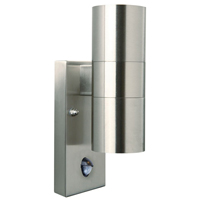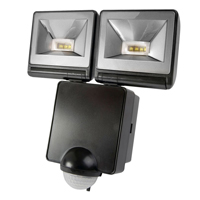There are so many outdoor lights to choose from, it can be hard making a choice when it comes to creating the right ambience for clients, customers or employees. With the British weather usually being on the unpredictable side, we have brought together the top ten outdoor lights that will help you make the most of your outdoors. From security lights to LED planter lights, we cover the whole range of outdoor lights, with one or two suggestions that will hopefully fulfill your needs! But what’s top of our charts and do you agree with us? Take a look at our countdown to find out…
10. Edit Cloud LED Ground Light
An outdoor light that makes a wonderful contemporary statement. Your customers or clients will love sitting in the garden with these inviting Edit Cloud ground lights dotted around the garden. LED Clouds are perfect for hotel, restaurant or bar gardens.
9. Edit Dune Post Light
The Edit Dune Post Light is very sleek and brings a sophisticated, contemporary look to your premises, thanks to its thin design and stainless steel casing .Its IP44 rating makes it suitable for life outside. Use it to light up garden paths, or driveways for your employees and customers, allowing them to work or relax in comfort. Create soft, ambient lighting with these wonderful outdoor post lights.
8. Nordlux Twin Wall Light
 Carrying on the theme of sleek and contemporary is the Stainless Steel Twin Wall Light, which gives a column of light both above and below the fitting. This outside light is perfect for creating ambient lighting outdoors. It has a quality Danish design that won’t let you down – perfect for use in public places.
Carrying on the theme of sleek and contemporary is the Stainless Steel Twin Wall Light, which gives a column of light both above and below the fitting. This outside light is perfect for creating ambient lighting outdoors. It has a quality Danish design that won’t let you down – perfect for use in public places.
Its durable IP54 Rating means it can withstand the harsh outdoors without losing function.
7. Albany Walkover Light
 Next we have the Albany walkover light. This submersible light has an incredible IP68 Rating. Completely watertight, this durable light is perfect for lighting paths and decking where water might accumulate. It can even withstand water up to 1m deep – use it to illuminate water features, ponds and waterfalls. This is a great tool if revamping a garden for clients or if you want to set your hotel, restaurant or pub grounds apart from others.
Next we have the Albany walkover light. This submersible light has an incredible IP68 Rating. Completely watertight, this durable light is perfect for lighting paths and decking where water might accumulate. It can even withstand water up to 1m deep – use it to illuminate water features, ponds and waterfalls. This is a great tool if revamping a garden for clients or if you want to set your hotel, restaurant or pub grounds apart from others.
6. Twin LED PIR Floodlight

Keep you, your premises, customers and employees safe with this Searchlight LED Twin Flood Light with PIR Sensor. What better way to feel safe and secure on your premises after dark than with this LED Floodlight. This outdoor security light is incredibly low energy; it’s equivalent to 70W incandescent light output and yet uses only a fraction of the energy. Work or relax with the peace of mind that quality security brings.
5. Vejers Down Wall Light
 Bring a touch of Scandinavian design to your garden with this Vejers down wall light – Galvanised. Incredibly sturdy and durable with an IP54 Rating, in its galvanized finish, this light functions fully even when exposed to harsh elements in coastal locations. Use it to light up the outside of buildings, even in exposed weather and rest assured it won’t let you down. The downlight design also makes it a good tool for lighting up areas of outside space you want to be seen such as plant displays.
Bring a touch of Scandinavian design to your garden with this Vejers down wall light – Galvanised. Incredibly sturdy and durable with an IP54 Rating, in its galvanized finish, this light functions fully even when exposed to harsh elements in coastal locations. Use it to light up the outside of buildings, even in exposed weather and rest assured it won’t let you down. The downlight design also makes it a good tool for lighting up areas of outside space you want to be seen such as plant displays.
4. Twilight Ground Lights

Next up we have the Mini Cool White LED Ground Light, which come complete with everything you need to install instant glamour to an outside decking space. These outside ground lights fit your decking no matter what the size. These decking lights come in a variety of colour temperatures to make your decking area a cosy ‘inside’ area, outside.
3. Protect Wall Light
 At three, we have the Protect Wall Light, which is completely rain and weatherproof thanks to a brilliant IP66 Rating. Vandal proof and completely energy efficient, this excellent light reduces glare and enables you to direct the light exactly where you need it, helping your employees or clients to work or relax in comfort.
At three, we have the Protect Wall Light, which is completely rain and weatherproof thanks to a brilliant IP66 Rating. Vandal proof and completely energy efficient, this excellent light reduces glare and enables you to direct the light exactly where you need it, helping your employees or clients to work or relax in comfort.
2. Luxembourg PIR Wall Light
 The Luxembourg PIR Wall Light combines the best of everything. It looks beautiful and has a unique design that won’t go out of fashion. This outside wall light has been made with incredibly durable galvanised steel and has a quality Danish design, which has been designed to withstand harsh weather conditions as seen on the coast. It has an amazing fifteen year anti-corrosion guarantee, which displays how much faith the manufacturer’s have in it. An excellent IP54 rating means it won’t let you down, even when exposed to the harshest elements. A PIR motion sensor helps keep you, your premises and the people you look after, secure.
The Luxembourg PIR Wall Light combines the best of everything. It looks beautiful and has a unique design that won’t go out of fashion. This outside wall light has been made with incredibly durable galvanised steel and has a quality Danish design, which has been designed to withstand harsh weather conditions as seen on the coast. It has an amazing fifteen year anti-corrosion guarantee, which displays how much faith the manufacturer’s have in it. An excellent IP54 rating means it won’t let you down, even when exposed to the harshest elements. A PIR motion sensor helps keep you, your premises and the people you look after, secure.
And here it is! As voted by us…
1. GuardCam LED Security Floodlight
 The GuardCam LED Security Floodlight is an amazing all-in-one PIR security light, speaker, DVR system and camera. It not only light up your premises when it senses motion, but also records whatever has triggered the sensors directly on to an included 2GB SD memory card. You can choose between still frames or video format while the latest LED technology ensures that even night time footage is seen colourfully and clearly. Whether you want to guard commercial or domestic properties or grounds, this brilliant floodlight won’t let you down. See alternatives here.
The GuardCam LED Security Floodlight is an amazing all-in-one PIR security light, speaker, DVR system and camera. It not only light up your premises when it senses motion, but also records whatever has triggered the sensors directly on to an included 2GB SD memory card. You can choose between still frames or video format while the latest LED technology ensures that even night time footage is seen colourfully and clearly. Whether you want to guard commercial or domestic properties or grounds, this brilliant floodlight won’t let you down. See alternatives here.
Don’t forget to scour the rest of our outdoor lights.
Looking for more news, inspiration and advice? Try our Lighting Advice section.

Charles Barnett Managing Director
Charles started Lyco in 1995 with just 4 enthusiastic employees and has grown it considerably over the past 25 years. Charles is also the Managing Director of Lighting Direct and newly acquired Online Lighting. He now has a team of 50 lighting experts working on growing Lyco Group to be the UK leader in lighting for both businesses and homes. Away from the office he is a keen cyclist and is proud to have cycled 1017 miles from Lands End to John O’Groats to raise money for a new residential centre for adults with multiple learning difficulties.











